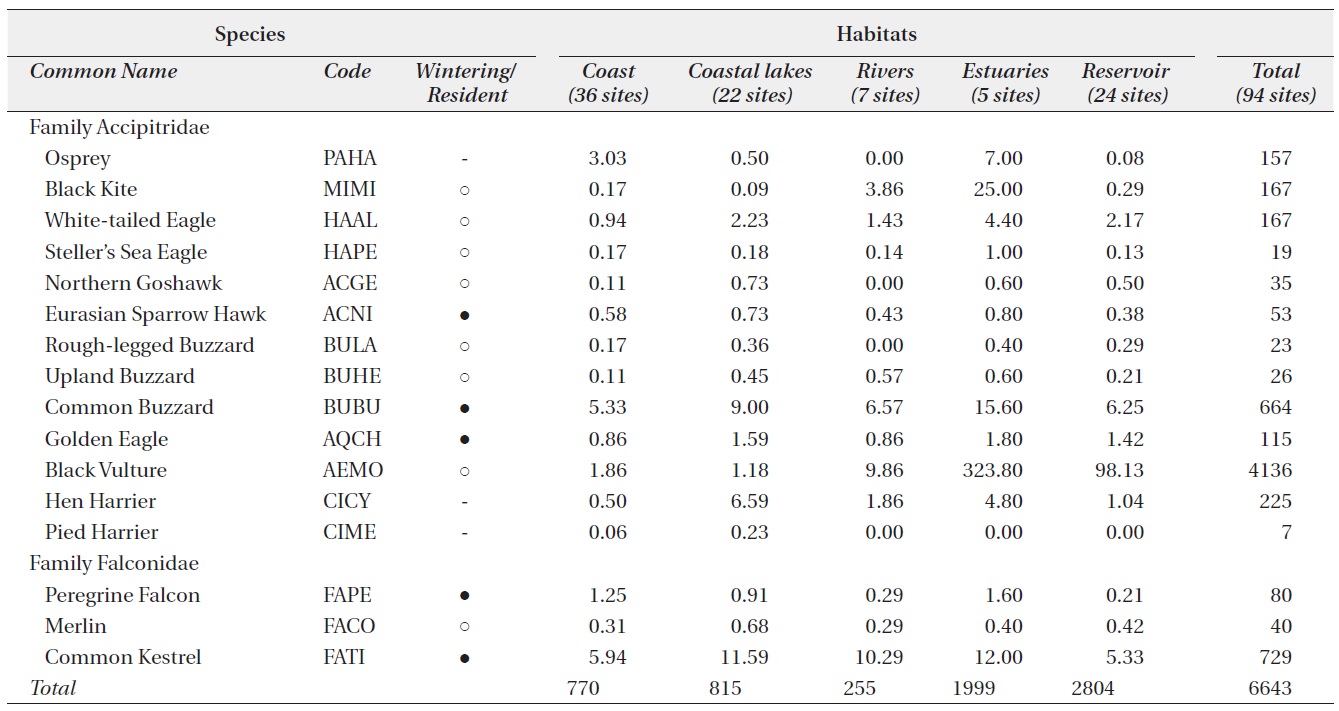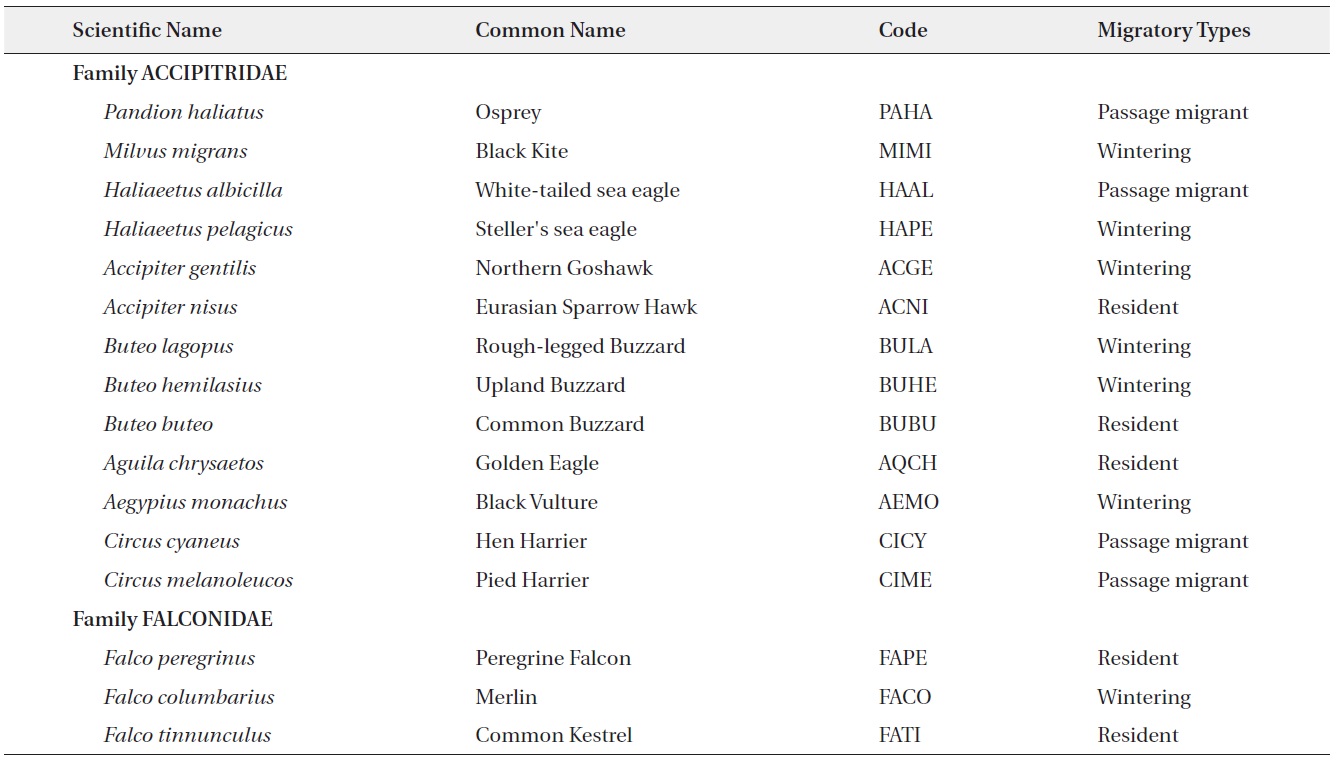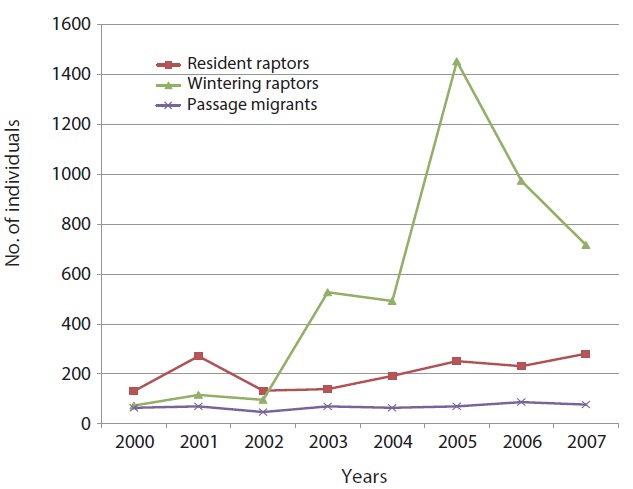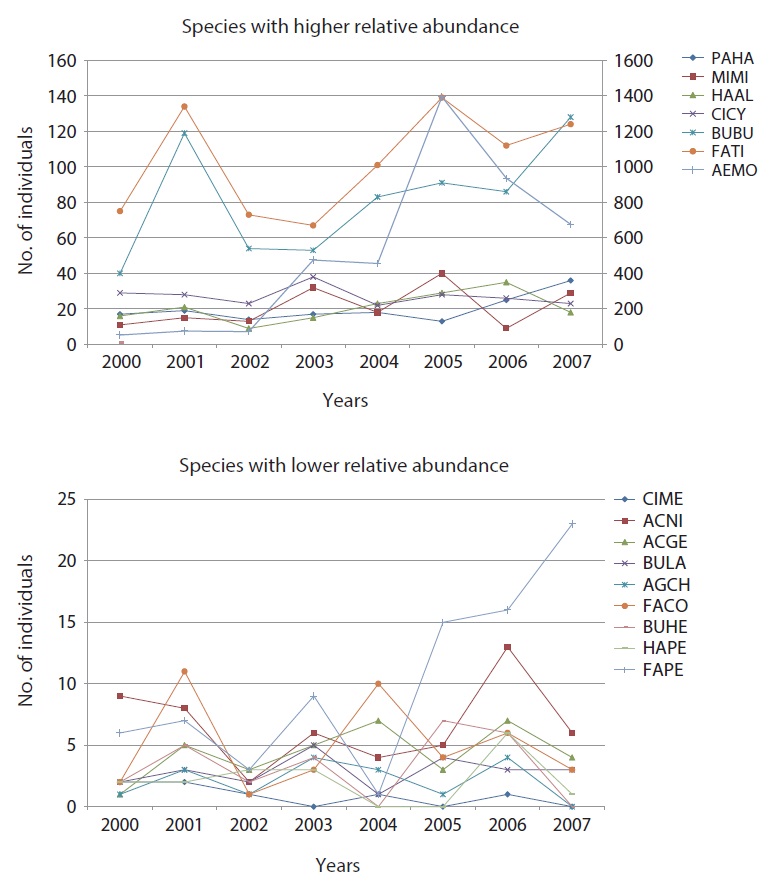



Studies on the distribution and abundance of raptors are rarely conducted in the Republic of Korea (ROK). However, the importance of raptors in conservation comes from several conceptual qualities. Firstly, raptors are considered as an umbrella species with low population densities and large individual home ranges so that most raptors are indicative to change in natural ecosystem. Secondly, they can act as valuable indicator species on changes and stresses in ecosystems, as they are quite sensitive to changes in habitat structure and fragmentation and have a high susceptibility to local extinctions (Simberloff 1998). Thirdly, conservation efforts can be more efficient when oriented to flagship species like raptors (Simberloff 1998, Sergio et al. 2005). Currently no assessment has been made in the distribution and abundance of raptors in ROK which hampers understanding their ecology and habitat usage and efficient conservation on raptors.
I assume that main causes of threat to raptors in ROK are anthropogenic factors such as reclamation, rapid urbanization, and intensive agriculture. Different types of landscape alterations may have different effects on raptor populations, depending on the type and intensity of disturbance, and on the characteristics of the species involved (Palomino and Carrascal 2007). Detrimental impacts on raptors have been documented as a result of habitat loss and fragmentation (Thiollay and Rahman 2002) and direct disturbance derived from human presence and associated infrastructure (Zelenak and Rotella 1997).
Most urbanized areas on the Korean peninsula are located along or near the highly indented western and southern coasts, where numerous fishing villages and vast tidal flats are well developed. In contrast, the peninsula’s eastern seaboard is generally uniform with extensive underdeveloped coastlines. Most of the mountainous terrain is located north, where there are few arable (farmable) plains. The few remaining dense forests are located in the far north. In this study we aimed to define distribution and abundance of raptor species which occur in different habitats and to explain it referring to the environmental factors in those habitats.
Contemporary count data were used from a wintering bird census coordinated by the National Institute of Environmental Research (NIER, http://www.nier.go.kr). The NIER census was started in 1999 and entails an annual one-day count in January (or early February) of all bird species by site with results then published by the National Ministry of Environment of Korea. The annual NIER Census Reports of 1999, 2004, 2005, 2006 and 2007 listed the abundance of all bird species recorded by site, with 56 sites covered in 1999 increasing to 128 sites counted in 2007. Analysis was focused on 94 sites that were surveyed in all the years because of data differences.
In the absence of a complete methodology, the NIER census reports provide the best data for establishing current habitat usage of wintering birds in ROK (Moores et al. 2010). Although NIER census reports also have limited value for developing national population estimates or identifying population trends especially of shy or localized birds, preliminary analysis indicates that the data do reveal population trends in several more widespread and easy-to-identify species at the national level (Moores et al. 2010).
Based on the description of sites, study areas were divided into 5 habitat types; coasts, coastal lake/reclaimed areas, rivers, estuaries and reservoirs (e.g., dam lakes). For statistical analysis, 16 raptor species, which were recorded at least 5 times during the 8-year annual census, were chosen as study species. Relative abundance of the raptor species were calculated annually and spatially and dynamics of the abundance over time were estimated using linear regression.
In order to compare the rate of changes in raptor community per sites across regions, I estimated regional diversity indices for inland region which comprised of 28 count sites, for west coast with 27 sites, for south coast with 24 sites and for east coast with 15 sites by calculating Beta diversity index or Whittaker’s measure as follows:
β = S/α - 1, where S is the number of species in the entire set of sites and α is the average number of species per sites.
The lower values indicate a homogeneous landscape with respect to particular environmental factor while higher values (no upper limit, but empirical values above 10 are rare) indicate heterogeneous landscape characterized with various factors (Van Dyke 2008).
A total of 6,643 individuals from 16 species were recorded at 94 count sites all over Korea from 2000-2007. Among 16 raptor species, 13 species were from family Accipitridae and remaining 3 species were from family Falconidae (Appendix 1). Five species were resident birds including Common Buzzard (
Wintering raptor species showed high fluctuation in abundance (Fig. 2). A sudden increase of wintering raptors during 2005 and 2006 seems to be due to that of Black Vulture. Great flocks of the Black Vulture were found in 2005 in the estuary of Imjin River (1,123 individuals) and in 2006 at Cholwon plain (604 individuals). Those areas are both located in the northern part of ROK and a borderline of DMZ (Demilitarized Zone) where the forested mountains and relatively undisturbed landscapes dominate.
According to the result of regression analysis on relative abundances of species by years, the Black Vulture (r2 = 0.60,
This implied that there are differences in abundance
depending on habitat types (Table 1). For instance, in estuaries areas the dominant species was Black Vulture
= 323.8 individuals/site) whereas in coastal lakes the dominant species were Common Kestrel
= 11.59).
On average, the abundance of raptors in reservoirs
= 116.83) and estuaries
= 399.8) were higher than
[Table 1.] Summary of relative abundances of mean by each species at 5 different habitats

Summary of relative abundances of mean by each species at 5 different habitats
those in coastal lakes
= 37.04), coasts
= 21.39) and rivers
= 36.4) (
= 8.42) and south
= 6.31) coasts were higher than that in the east coast
= 1.51) (data not shown) (
The value of the beta diversity index was 4.96 for the south coast, 5.1 for the west coast, 5.25 for east coast and 6.43 for the inland region. These values can simply demonstrate that coastal regions have small rate of changes in raptor species composition and are considered as homogenous landscapes with respect to particular environmental variables. On the other hand, inland regions might be heterogeneous landscapes characterized by various environmental factors and have greater rate of change in the raptor community across its sites because of the higher beta index value.
The purpose of the study was to define the distribution and abundance of raptor species in different habitats of the Korean peninsula and to explain them in relation to environmental factors in those habitats.
Among all raptors counted, wintering raptors were in the majority (67.2%), and they were not stable in abundance between the study years (Fig. 1). The sudden increase of Black Vulture abundance in 2005 and 2006 is related to their increase in total population (Fig 3). In the inland part of Korea such as Cholwon started to provide winter feeding program targeting to Black Vulture due to its status of Natural Monument (#243) in Korea (http://www.cha.go.kr). Similarly increase in relative abundance was observed with other waterfowl birds such as Baikal Teal (
Coastal habitats and biodiversity are threatened by land reclamation in Korea (Kim et al. 2003). The fact that twice as many raptors were found in inland areas than coastal areas indicates that coastal regions are suffering from the pressure of land reclamation, farming, urbanization and industrialization (Table 1). In this study, Common Kestrel and Common Buzzard were dominant species in coastal areas including habitats such as coasts, coastal estuaries, and reservoirs/reclaimed areas. The same result has been found in the surveys in agricultural areas of eastern Kazakhstan and it was suggested that transformation of the natural habitats into agricultural land has some positive effect for small to medium-sized raptors by increasing small rodents (Sanchez-Zapata et al. 2003). Besides it has been noted that some raptors such as Common Buzzard favor habitats with other open lands, and avoid poor homogeneous habitats (Bustamante and Seoane 2004, Palomino and Carrascal 2007).
It appeared that habitat use of resident raptor species was also driven by other historical or evolutionary factors. Resident raptor species such as Common Buzzard, Common Kestrel in this study had much higher abundance in the coast and coastal regions (Table 1). This might suggest that occupancy pattern of a species be partially driven by historical reasons, intraspecific and interspecific interactions. It might be possible that resident birds have better adapted to inland areas which are more familiar with for settlement during breeding and survival. Furthermore it becomes clear that the water channels and reservoirs set up for farming purposes support some water birds in wetlands and birds of prey use rice paddies to chase and capture ducks and small rodents for food (Kim et al. 2003, Legendre et al. 2002). Coastal area also showed the lower value of Whitaker measure presumably indicating that birds in the coastal areas are evenly distributed than in inland areas. On the other hand, higher beta index of inland regions suggest that inland regions might provide heterogeneous landscapes characterized by various environmental factors and have greater rate of change in the raptor community across the sites (Van Dyke 2008).
Large scale modification of inland streams and wetland areas into reservoirs and dams could have negative impacts on biodiversity including water birds, fishes etc., due to seasonal water level change from flooding, temperature and oxygen in deep water, summer monsoon effects, and also reservoirs maybe colonized by species which are a vector of human and animal diseases (Kim et al. 2000).
In conclusion, this study revealed spatial and temporal patterns in the abundance of raptors in ROK. The data from the NIER census are a large set data and cover most landscape areas in Korea so that population monitoring could require time and large number of people. This study, therefore, is the first to provide scientific evidence on population changes in raptors over the past 8 years in ROK. The results provide an important basis for taking appropriate conservation measures and improving the quality and quantity of nationwide surveys of birds of prey.
[Table 2] Family, common name and scientific name of species used in this study

Family, common name and scientific name of species used in this study




